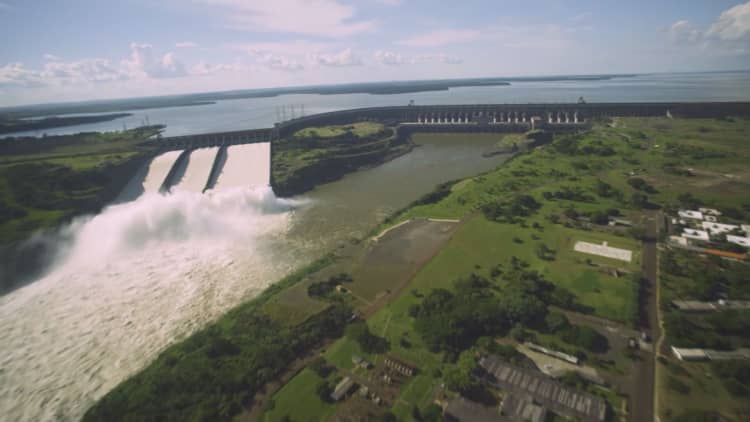Across the world, countries are building dams to create electricity and boost their economies, but the risks could outweigh the benefits.
Dams often inflicts environmental damage to aquatic eco-systems that creates socio-economic risks to communities dependent on rivers and lakes for their livelihoods. The problem is especially urgent in Southeast Asia, where dams are constructed in the Mekong River for hydropower.
Flowing through Laos, Cambodia, Thailand, Myanmar, Vietnam and China, the Mekong is the world's 10th-largest river and the world's largest inland fishery. It is home to biodiversity that's second only to the Amazon River and boasts immense economic value. It accounts for 25 percent of the global freshwater catch and some 60 million people make an income off the fish as well as crops grown along the river banks.
But hydropower dams on the river are hurting fish stocks and eroding soil fertility, potentially jeopardizing the Mekong's future as a life-sustaining ecosystem. Around 11 mainstream dams and more than a hundred tributary dams are planned by 2040 as regional governments tap their hydropower capacity amid soaring power demand.
Laos has obtained billions from hydropower investors and wants to export the electricity generated by dams to its neighbors in a quest to become the "battery of Asia." The landlocked nation exported electricity worth about $975 million in the first nine months of 2017, according to the International Hydropower Association.
Southeast Asia's electricity shortage makes hydropower an attractive, clean energy source and a valuable source of revenue. Seen as a long-term solution to poverty in rural areas, hydropower also provides water for consumption, storage, irrigation and flood control.
Environmentalists, however, believe hydropower may be doing more harm than good.
Environmental threats
Fish that call the Mekong home move upstream to spawn, but dams and associated reservoirs block their passage, interrupting their life cycles. Fish stocks are expected to fall by up to 40 percent as a result of hydropower projects, according to an April report by the Mekong River Commission, an organization governed by ministers from Cambodia, Laos, Thailand and Vietnam.

Dams reduce the amount of sediment flowing downstream, which lowers soil fertility. Without sediment, the banks of rivers and canals will erode, sending homes, crops and infrastructure into the water, experts say.
"Sediment flows are critical to a river's eco-system and if you change the flow of sediment, you get a different river," said Marc Goichot, a water specialist at the World Wildlife Fund's Greater Mekong Program. "Before the first dam in 1990, the Mekong was releasing 160 million tons of sediment on average per year and, in 2014, that figure was more than halved."
Dams also contribute to the sinking of deltas, forcing households to resettle elsewhere.
"If annual contribution of sediments to the delta is reduced, then erosion from the sea on the delta may increase, which in turn may result in loss of land in that area," explained Mats Eriksson, senior manager of the transboundary water management department at the Stockholm International Water Institute.
Economic impact
Hydropower acts as a catalyst for economic growth, according to its advocates.
"Hydropower projects can promote socially inclusive sustainable development, provided they have a strategic fit and are developed and operated sustainably," said Richard Taylor, chief executive of the London-based International Hydropower Association. "Properly planned hydropower projects of all sizes can result in net-benefits to the planet, local communities and energy and water systems."
But critics say the hit to food security and agricultural productivity from decreased sediment flows will trigger higher poverty levels as well as climate vulnerability. That could ultimately depress economic growth in all Mekong countries downstream of China, according to the Mekong River Commission report.
In fact, a 2017 study published by international non-governmental organization Oxfam said that commonly cited economic benefits of hydropower are grossly overestimated. The net present value for the planned dams is estimated at negative $7.3 billion, the study found.
Malaysia's Mega First and China Southern Power Grid, which are behind the Don Sahong dam in southern Laos and Cambodia's Sambor dam, respectively, didn't respond to CNBC's request for comment.
Suitable answers
Solutions applied to other parts of the world facing similar dam-related issues aren't always appropriate for the Mekong as its rich biodiversity sets it apart from other bodies of water.
For example, some countries have used so-called fish ladders — structures built along the side of a dam that allow fish to pass over and spawn upstream.

Ladders, according to Goichot, are costly and only suited to fish with the right swimming ability. "With the Mekong's diverse number of species, we simply don't know if all fish will be able to pass through the ladder," he said. "Colombia's had the most success with fish ladders for about five species, but in the Mekong, you get more fish biomass in one hour than the entire year in Colombia."
In the United States, the Mississippi River Delta is sinking due to insufficient sediment supply and officials have taken to reconstructing natural sediment flows — a highly expensive feat that isn't feasible for developing Southeast Asian nations.
Also complicating the process is the fact that review processes for tributary dams isn't covered under the mandate of the Mekong River Commission. Instead, "they come together under often murky, non-transparent circumstances and often have zero mitigation measures for key environmental flows," said Brian Eyler, director of the Southeast Asia program at Washington-based policy research organization the Stimson Center.
None of the seven Chinese-built dams on the Nam Ou cascade in northern Laos, for example, have fish ladders or sediment flushing gates, he added.
Vietnam, for one, has already urged Laos to rethink its plans for more dams.
"Vietnam wants all upstream Mekong River nations to adopt proper policies in exploiting the river, especially in hydropower dam construction, in order to ensure rights for downstream nations, like Vietnam," Vietnamese Minister of Natural Resources and Environment Tran Hong Ha said at a 2017 conference.
Poor infrastructure assessments
Dams can also be dangerous ventures for developing countries lacking adequate planning and readiness for disasters.
Last month, the Xepian-Xe Nam Noy dam in Laos' Attapeu Province collapsed during heavy rainfalls, leaving neighboring villages hit by massive flooding, with thousands displaced and hundreds missing. The dam was part of a larger hydroelectric project run by the Xe Pian Xe-Namnoy Power Company, a joint venture between South Korea's SK Engineering & Construction and Korea Western Power. Industry professionals said the disaster was, beyond a doubt, man-made.
Developers knew that the dam was threatened by intense weather patterns beforehand and could have drawn the reservoir down to prevent the dam breach, according to Eyler. A warning was issued to the Lao government, but it only came hours before the dam breach and it's unlikely that villages received notice early enough to prepare, he added.
SK Engineering & Construction and Korea Western Power didn't respond to CNBC's request for comment. Share prices of the two biggest shareholders in SK Engineering & Construction — SK Holdings and SK Discovery — fell 6.2 percent and 10 percent, respectively, following news of the tragedy.
Unsatisfactory environmental and social impact studies were also factors in the disaster, as was weak monitoring.
The collapse of the dam in Laso, according to Eriksson, shows it is of the "uttermost importance to properly plan any infrastructure interventions in a river." When a private company undertakes such construction, there is a need for strong regulation and government oversight, he said.
Thailand's Ratchaburi Electricity Generating Holding, which holds a 25 percent stake in the Xe-Pian Xe-Namnoy dam, didn't respond to CNBC's request for comment.
Looking ahead
Hydropower structures need to be developed in Asia, but only if rigorous processes are in place, according to Eriksson.
Given the hazards, however, others believe governments should switch to less risky renewables.
"Emerging technologies such as solar, wind, and biomass are now competitive in the region and have the potential to replace some of the most damaging dams," said Eyler. "Vietnam, which stands to lose the most from upstream dams, could make a convincing case to Laos to diversify its energy generation options and invest in solar, wind, and biomass for export to Vietnam," he explained.

